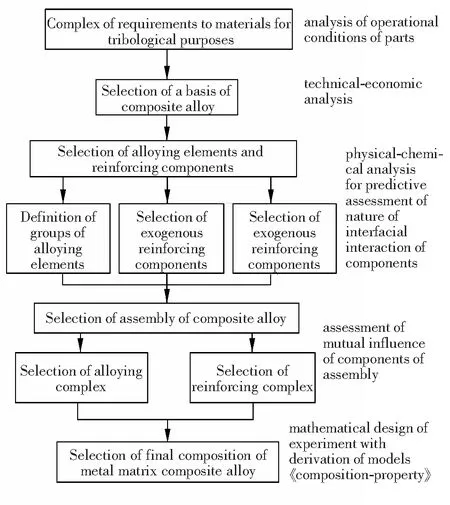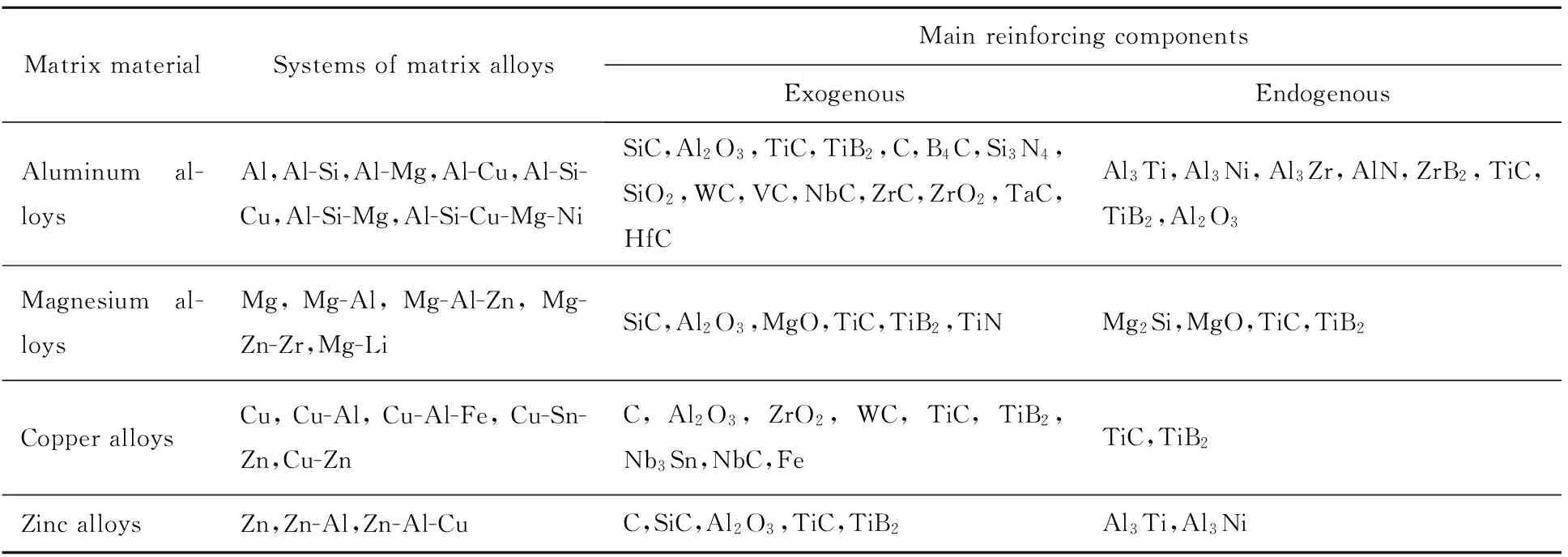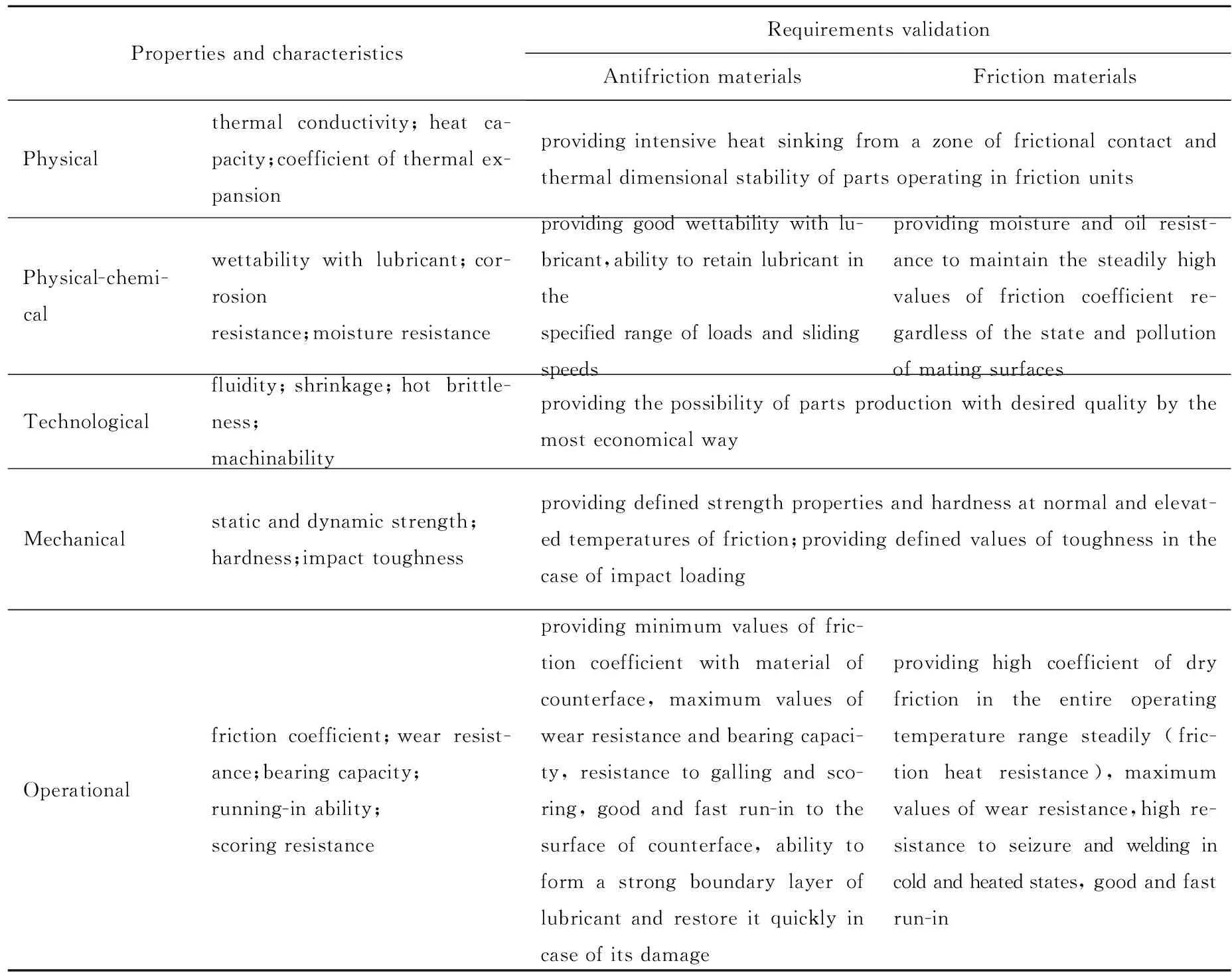Methodological aspects of metal matrix composites design for tribological purposes
2016-12-09.,.
., .
(Vladimir State University named after Alexander & Nikolay Stoletovs, Vladimir 600000, Russia)
Methodological aspects of metal matrix composites design for tribological purposes
EvgenyS.Prusov,VladimirA.Kechin
(Vladimir State University named after Alexander & Nikolay Stoletovs, Vladimir 600000, Russia)
Development of new alloys has been slowed down by empirical method of trials and errors that wastes more and more resources and leads to smaller results. Solution to this problem is possible through the use of general principles of the alloys design theory. This paper is an effort to consider cast metal matrix composites as foundry alloys and developed a methodological approach to selection alloying and reinforcing components considering the operational conditions for parts of friction units.
metal matrix composites; design of alloys; friction; wear
0 Introduction
Possibilities of increasing mechanical and operational properties of conventional alloys by now have been almost exhausted[1-3]. Significant reserves in enhancing these properties open at realization of the reinforced heterophase structure principle that is the basis for metal matrix composites creation including composite alloys[4]. Casting composite alloys is a special class of materials for functional and constructional purposes, consisting of a metal base(matrix) reinforced with uniformly distributed high-melting discontinuous particles of exogenous or endogenous origin, which aren’t dissolved in the matrix metal at temperatures of production and exploitation of materials[5]. Along with the increase of mechanical properties, using composite alloys allows to improve tribological characteristics of cast products(bearing capacity, wear resistance, running-in ability, scoring resistance etc.) significantly and expand the temperature and power ranges of their performance.
Despite the progress of the leading world research teams in the field of metal matrix composite alloys creation, unified methodological principles of the design for reaching consistently defined properties have not been developed so far. The problem of finding optimal compositions of alloying and reinforcing complexes in the development of multicomponent composite alloys is connected with large-scale expenses of time and material resources. Within the methodological approach in designing metal matrix composite alloys, it is necessary to develop criteria for selecting matrix alloys and reinforce components considering operational requirements and systematization of various alloying elements according to the nature of their interaction with components of composites with relation to the desired microstructure formation and achievement of the predefined level of adhesive bonds at the interfaces.
Thus, the development of scientific and methodological foundations of composite alloys design is one of the priorities of modern materials science, since traditional empirical method of new materials compositions selection fails to meet the increasing requirements for speed and quality of creation of alloys with desired properties. Effective and economic solution to this problem is possible by the use of fundamental principles of alloys design system in conjunction with physical-chemical and technical-economic analysis methods, as well as the multifactorial mathematical design of experiments with a derivation of functional equations “composition-property”:
Y=f(x1,x2,…,xn;X1,X2,…,Xm),
where (x1,x2, …,xn) ——alloying elements;
(X1,X2, …,Xm)——reinforcing components.
The aim of the present work is to develop the general principles of metal matrix composites design for tribological purposes according to the details on exploitation conditions.
1 Methods
The system analysis method is used in the development of the general concept of composite alloys design. The term “design of alloys” means the creation of new alloys with desired combination of mechanical and operational properties. The process of alloys design in traditional form is represented by the following stages: objective statement for alloy development; alloy basis selection; alloying elements selection and harmful impurities definition; alloying complexes selection; final alloy composition selection[6]. In this paper, we have proposed to consider cast metal matrix composites as foundry alloys. It allows to use the general principles of alloys design theory in their development, which is based on the physic-chemical analysis, Mendeleev’s Periodic Table of Elements and technical-economic analysis. Unlike conventional alloys, metal matrix composites have multiple levels of matrix strengthening, including major alloying elements of the matrix alloy, as well as exogenous and endogenous reinforcing particles. Within a system approach to optimization of composite alloys, composition selection of alloying and reinforcing components and their classification have been carried out.
2 Results and discussion
In generalized view, the stage-by-stage system of metal matrix composite alloys design for tribological purposes is presented in Fig.1. At the first stage the technical specification for the development of composite alloy has been formulated and the main requirements determined by operational conditions of details have been appointed. Selection of the basis of composite alloy has been carried out, according to the data of technical-economic analysis. It is worth to mentioning that most low-cost metal can’t always provide the greatest economic benefit. For example, it’s often advantageous to use more expensive base metal for parts of friction units of ground transportation and aviation technics if it has a lower density. Parts weight reduction will reduce fuel consumption and increase the mass of transporting freights, which makes cost-effective use of composite alloys based on aluminum and magnesium.
At present, almost all metals and alloys used in industry are tested as matrix materials for the composite alloys creation. Some examples of matrix alloys systems and reinforcing components are shown in Table 1[7-12].
As it can be seen in Table 1, both pure metals and their alloys can be used as matrix material. It is possible to use not only alloys with standard chemical compositions, but also create new matrix alloys compositions with considering the nature of interphase interaction of metal melts and reinforcing components. Aluminum matrix composite alloys have attracted attention of researchers since 1960th. And at present, they are most well studied. Analysis of the accumulated experimental data shows that these materials are effective alternatives to traditional tribological alloys, primarily expensive bronzes and tin-base babbitts, because they avoid scarce elements and decrease details mass at the same time increase the reliability and durability of friction units. As the reinforcing phases, disperse particles of oxides, carbides, borides, nitrides, intermetallics and other high-melting compounds are used in compos-ite alloys.

Fig. 1 Scheme of composite alloys design

MatrixmaterialSystemsofmatrixalloysMainreinforcingcomponentsExogenousEndogenousAluminumal-loysAl,Al-Si,Al-Mg,Al-Cu,Al-Si-Cu,Al-Si-Mg,Al-Si-Cu-Mg-NiSiC,Al2O3,TiC,TiB2,C,B4C,Si3N4,SiO2,WC,VC,NbC,ZrC,ZrO2,TaC,HfCAl3Ti,Al3Ni,Al3Zr,AlN,ZrB2,TiC,TiB2,Al2O3Magnesiumal-loysMg,Mg-Al,Mg-Al-Zn,Mg-Zn-Zr,Mg-LiSiC,Al2O3,MgO,TiC,TiB2,TiNMg2Si,MgO,TiC,TiB2CopperalloysCu,Cu-Al,Cu-Al-Fe,Cu-Sn-Zn,Cu-ZnC,Al2O3,ZrO2,WC,TiC,TiB2,Nb3Sn,NbC,FeTiC,TiB2ZincalloysZn,Zn-Al,Zn-Al-CuC,SiC,Al2O3,TiC,TiB2Al3Ti,Al3Ni
Selection of series of alloying elements and reinforcing components is based on the physical-chemical analysis method for the predictive assessment of nature and mechanism of components interaction with each other and with matrix alloy. Criterion approach, based on the results of metal-chemical and technical-economic analysis, allows to allocate groups of reinforcing components for matrix alloys by indicating the possibility of heterogeneous structure formation, thermodynamic stability, minimum solubility in matrix metal at temperature of manufacturing and exploitation, lack of phase transformations at a temperature range of parts working and some other criteria. One of the main criteria for alloying components selection is supposed to consider their influence on the interaction between matrix alloys and exogenous reinforcing particles. Application of the stated approach allows to choose components of metal matrix composite alloys with various schemes of reinforcing reasonably, including exogenously reinforced, endogenously reinforced and complex reinforced alloys. It is necessary to use the method of experiments design for relevant mathematical models derivation at the stage of the optimal composition of metal matrix composite alloy selection, including alloying elements concentration ranges and reinforcing components volume fractions.
Appropriate selection of new materials for parts of friction units is possible only if assessment of constructional and tribological characteristics of unit and conditions of its exploitation was carried out. Analysis of fundamental scientific works on friction and wear allows to systematize the main requirements to the materials for tribological purposes(Table 2). Generally, up to date, principles for wear-resistant materials selection are characterized by the fact that it is necessary to choose or create materials corresponding to the parts application and their exploitation conditions for each type of wearing (abrasive, hydroabrazive, impact abrasive, erosion, fatigue, etc.). For example, the requirements of antifriction materials depend on specific load, sliding speed, existence and type of lubrication, heat sinking conditions and some other factors. Operating conditions of frictional materials involves a wide range of speeds and loads, as well as significant and cyclical heating of friction surfaces due to the friction without lubrication. The full record of all requirements categories allows to choose materials for parts operating in friction units.

Table 2 Materials requirements for tribological purposes
According to the above scientific provisions, authors have carried out the research on how to create new complex-reinforced composite alloys. Liquid-phase technology applied to the production of cast metal matrix composites is based on the input of pressed powder preforms containing reactionary active components in matrix melts. Material on the base of aluminum alloy reinforced by the endogenous compounds TiB2, Al2O3, Al3Ti and exogenous particles of silicon carbide can be an example of the designed composite alloys[13]. Experimental results obtained from complex reinforcing of aluminum alloys show that as-cast hardness increases by 35%-40%, friction coefficient under boundary lubrication reduces by 5-7 times and wear resistance increases by 10-12 times in comparison with the matrix alloy. Produced composite alloys pass pilot industrial tests as excavator rollers bushings. During the test, it has been found out that the bushings manufactured from complex-reinforced composite alloys are characterized by higher wear resistance in comparison with bushings from antifrictional bronzes and provide high operational reliability of the equipment. The equipment operating cycles between overhauls increases by 3.5-4.0 times after replacing the bushings material. As a whole, the results of the industrial testing of the designed aluminum matrix composite alloys show their perspectives in the implementation of mechanical engineering for improving the reliability and durability of friction units of machines and mechanisms in various fields.
3 Conclusions
The main materials requirements for tribological purposes have been systematized according to operational conditions of friction units’ parts. For the selection of the optimal compositions of alloying and reinforcing complexes of composite alloys for tribological purposes, it has been recommended to use the general principles of alloys design theory. Application of the proposed methodological approach allows to make reasonable choice of metal matrix composite alloys components within conditions of various schemes of reinforcing, including exogenously reinforced, endogenously reinforced and complex reinforced alloys.
Acknowledgments:
This research has been carried out in the framework of the state task of the Ministry of Education and Science of the Russian Federation (Project No.3022).
[1] XUE D, BALACHANDRAN P V, HOGDEN J, et al. Accelerated search for materials with targeted properties by adaptive design[J]. Nature Comm, 2016, 7: 11241.
[2] SRINIVASAN S, BRODERICKS R, IHANG R, et al. Mapping chemical selection pathways for designing multicomponent alloys: an informatics framework for materials design[J]. Sci Rep, 2015, 5: 17960.
[3] VOJTECH D. Challenges for research and development of new aluminum alloys[J]. Metalurgija, 2010, 49(3): 181-185.
[4] MORTENSER A, LLORCA J. Metal matrix composites[J]. Ann Rev Mat Res, 2010, 40: 243-270.
[5] PRUSOV E S. Modern methods of metal matrix composite alloys production and new approaches to realization of reinforcing scheme[J]. Mach Tech Mat, 2014, 1: 11-13.
[6] KECHIN V A. Physical and chemical fundamentals of creation of cast sacrificial alloys[C]// METAL 2013: Proceedings. Ostrava: Czech Republic, 2013: 1144-1152.
[7] SURAPPA M K. Aluminium matrix composites: challenges and opportunities[J]. Sadhana, 2003, 28(1/2): 319-334.
[8] KAINER K U. Metal matrix composites: custom-made materials for automotive and aerospace engineering[M]. [S.l.]: Wiley-VCH, 2006.
[9] ASTHANA R. Reinforced cast metals: Part I. Solidification microstructure[J]. J Mater Sci, 1998, 33: 1679-1698.
[10] YE H Z, LIU X Y. Review of recent studies in magnesium matrix composites[J]. J Mater Sci, 2004, 39: 6153-6171.
[11] VYAS T K, PANDEY A, PATEL H. A review on investigation of copper matrix composite by using stir casting method[J]. Ind J Appl Res, 2015, 5(1): 75-77.
[12] MITROVIC S, BABIC M, STOJANOVIC B, et al. Tribological potencial of hybrid composites based on zinc and aluminium alloys reinforced with SiC and graphite particles [C]// Proceedings of 12th International Conference on Tribology. Kragujevac: Serbia, 2011: 138-145.
[13] PRUSOV E S, PANFILOV A A. Properties of cast aluminum-based composite alloys reinforced by endogenous and exogenous phases[J]. Russian Metallurgy, 2011, 7: 670-674.
(编辑 张迎春 校对 荀海鑫)
2016-07-14
The state task of the Ministry of Education and Science of the Russian Federation(Project No.3022)
Evgeny S.Prusov(1987-),Male,USSR,Ivanovo,Associate Professor,PhD(Candidate of Technical Sciences),Research field: Metallurgy and Materials Science, E-mail:eprusov@mail.ru.
TB331
2095-7262(2016)05-0564-05
A
基于摩擦学的金属基复合材料设计方法
EvgenyS.Prusov,VladimirA.Kechin
(弗拉基米尔州立大学, 弗拉基米尔600000, 俄罗斯)
传统实验方法存在资源浪费的问题,延缓了新型合金材料的研制,导致新型材料研制量降低。采用合金设计理论可以解决上述问题。将铸造金属基复合材料作为铸造合金,考虑部分摩擦单元工况,提出一种选择合金和增强组分的方法。研究结果表明,文中提出的方法允许在各种增强方案下使用,可以合理选择金属基复合材料的组分,包括外生增强、内生增强和复合增强合金。
金属基复合材料; 合金设计; 摩擦; 磨损
10.3969/j.issn.2095-7262.2016.05.019
